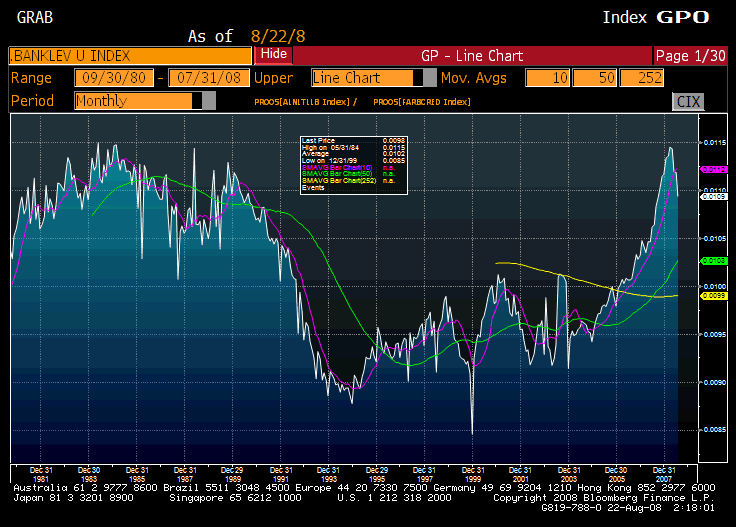The Fundamentals of Market Bottoms, Part 2
Before I get started for the evening, here is a copy of the Fed statements compared in PDF format, in case you couldn’t read it well on RSS.
Though this piece is about bottoms, not tops, I am going to use an old CC post of mine on tops to illustrate a point.
| David Merkel | ||
| Housing Bubblettes, Redux | ||
| 10/27/2005 4:43 PM EDT |
From my piece, “Real Estate’s Top Looms“:
Bubbles are primarily a financing phenomenon. Bubbles pop when financing proves insufficient to finance the assets in question. Or, as I said in another forum: a Ponzi scheme needs an ever-increasing flow of money to survive. The same is true for a market bubble. When the flow’s growth begins to slow, the bubble will wobble. When it stops, it will pop. When it goes negative, it is too late.
As I wrote in the column on market tops: Valuation is rarely a sufficient reason to be long or short a market. Absurdity is like infinity. Twice infinity is still infinity. Twice absurd is still absurd. Absurd valuations, whether high or low, can become even more absurd if the expectations of market participants become momentum-based. Momentum investors do not care about valuation; they buy what is going up, and sell what is going down.
I’m not pounding the table for anyone to short anything here, but I want to point out that the argument for a bubble does not rely on the amount of the price rise, but on the amount and nature of the financing involved. That financing is more extreme today on a balance sheet basis than at any point in modern times. The average maturity of that debt to repricing date is shorter than at any point in modern times.
That’s why I think the hot coastal markets are bubblettes. My position hasn’t changed since I wrote my original piece.
Position: none
I had a shorter way of saying it: Bubbles pop when cash flow is insufficient to finance them.? But what of market bottoms?? What is financing like at market bottoms?
The Investor Base Becomes Fundamentally-Driven
1) Now, by fundamentally-driven, I don’t mean that you are just going to read lots of articles telling how cheap certain companies are. There will be a lot of articles telling you to stay away from all stocks because of the negative macroeconomic environment, and, they will be shrill.
2) Fundamental investors are quiet, and valuation-oriented.? They start quietly buying shares when prices fall beneath their threshold levels, coming up to full positions at prices that they think are bargains for any environment.
3) But at the bottom, even long-term fundamental investors are questioning their sanity.? Investors with short time horizons have long since left the scene, and investor with intermediate time horizons are selling.? In one sense investors with short time horizons tend to predominate at tops, and investors with long time horizons dominate at bottoms.
4) The market pays a lot of attention to shorts, attributing to them powers far beyond the capital that they control.
5) Managers that ignored credit quality have gotten killed, or at least, their asset under management are much reduced.
6) At bottoms, you can take a lot of well financed companies private, and make a lot of money in the process, but no one will offer financing then.? M&A volumes are small.
7) Long-term fundamental investors who have the freedom to go to cash begin deploying cash into equities, at least, those few that haven’t morphed into permabears.
8) Value managers tend to outperform growth managers at bottoms, though in today’s context, where financials are doing so badly, I would expect growth managers to do better than value managers.
9) On CNBC, and other media outlets, you tend to hear from the “adults” more often.? By adults, I mean those who say “You should have seen this coming.? Our nation has been irresponsible, yada, yada, yada.”? When you get used to seeing the faces of David Tice and James Grant, we are likely near a bottom.? The “chrome dome count” shows more older investors on the tube is another sign of a bottom.
10) High quality companies keep buying back stock, not aggresssively, but persistently.
11) Defined benefit plans are net buyers of stock, as they rebalance to their target weights for equities.
I will try to complete this piece this week.? There should be one more part, and I will publish it all as one unit.


